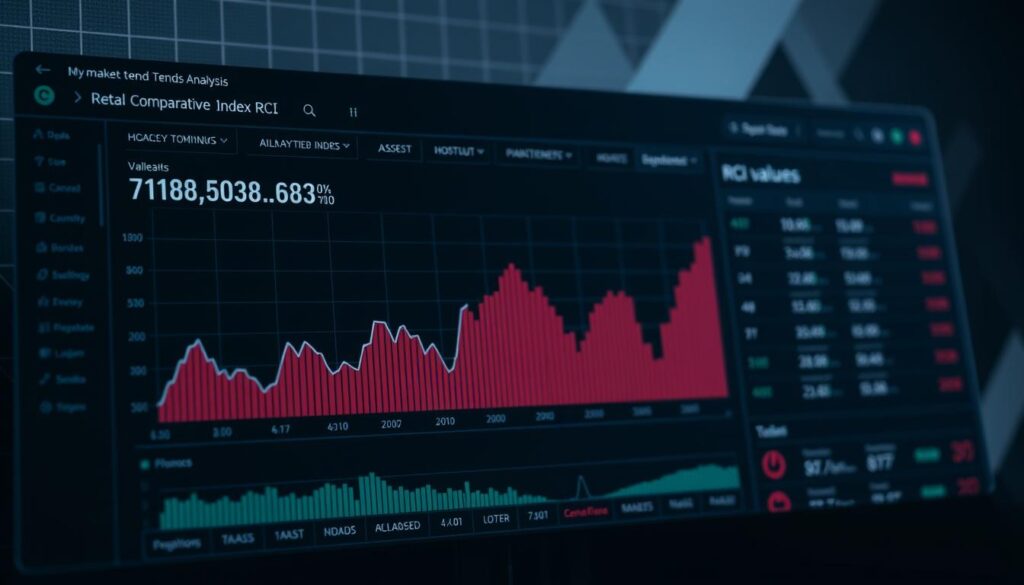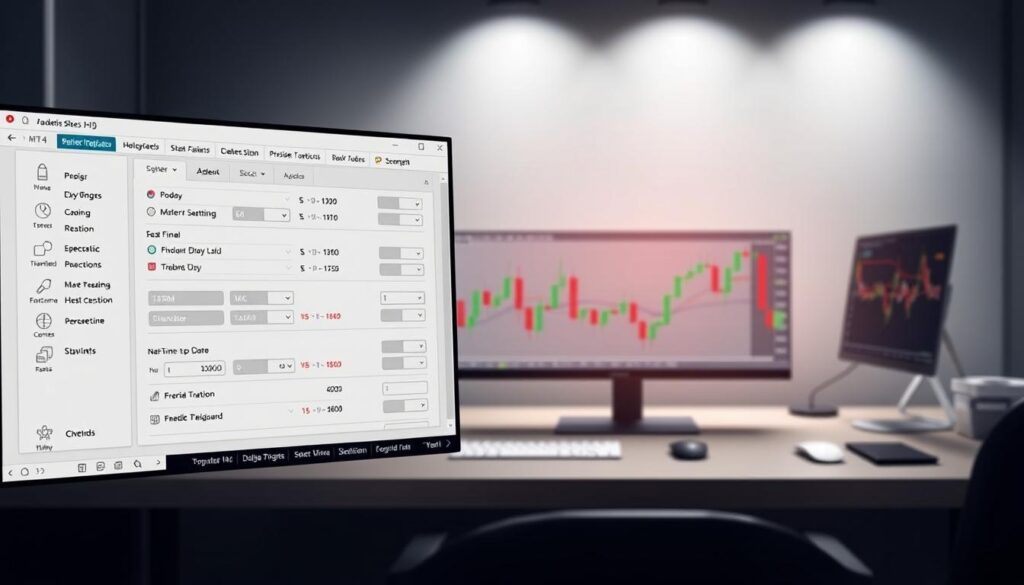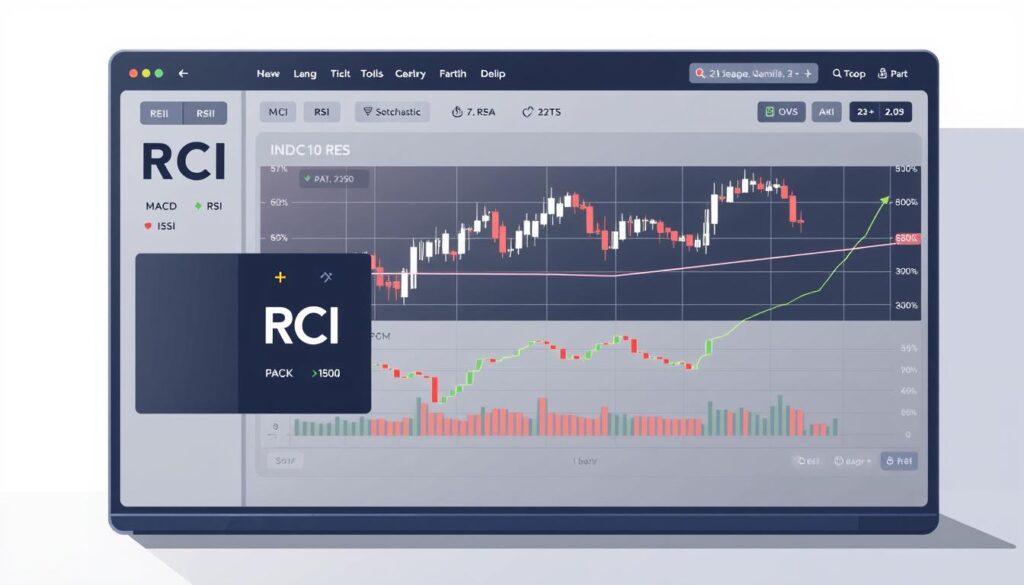How to Use MT4 RCI for Forex Trading Success
Forex traders in Indonesia are always searching for powerful tools to improve their results. This guide introduces a popular oscillator that measures rank correlation. It helps identify market momentum and potential turning points with great precision.
This unique indicator has gained global popularity. It analyzes price movements through a special rank correlation method. This is different from traditional price-based calculations.
Indonesian trading enthusiasts can leverage this tool to make better decisions. It quantifies the relationship between price ranking and time ranking over set periods. The indicator displays values from -100 to +100 as a simple line chart.
This visual clarity makes it accessible for both beginners and experts. This article provides step-by-step instructions and practical strategies. It is specifically tailored for forex traders in Indonesia looking to maximize their potential.
Introduction to the MT4 RCI Indicator
Navigating the complexities of the foreign exchange market demands tools that offer more than just price data. The Rank Correlation Index provides a sophisticated approach to technical analysis. It focuses on the statistical link between price movement and time.
Overview of the RCI Concept
This unique indicator differs from conventional oscillators. Instead of relying solely on price, it measures how price ranks correlate with time ranks over a set period. This method offers unique insights into market momentum and potential turning points.
The indicator displays its findings as a simple line oscillating between -100 and +100. This visual clarity helps traders quickly identify overbought or oversold conditions. It is a powerful tool for timing entry and exit points in trading.
Relevance in Today’s Forex Market
In today’s volatile market, Indonesian traders need tools that filter out noise. The RCI has proven effective across different environments. It works well in both strong trending markets and ranging markets.
Its mathematical basis provides quantifiable signals. This reduces emotional decision-making during analysis. The indicator’s versatility supports various strategies, making it a valuable asset for any serious trader.
Understanding the Rank Correlation Index (RCI)
Statistical correlation methods provide unique insights into price movement dynamics. The rank correlation index employs a special mathematical approach that differs from traditional price-based indicators.
Definition and Calculation
This correlation index works by assigning numerical ranks to both price data and time data. It then calculates the relationship between these ranked series using statistical methods.
The mathematical foundation compares the sequential order of prices against their chronological occurrence. This produces a value that reflects the strength and direction of the relationship between price movement and time progression.
Interpretation of Values from -100 to +100
Values approaching +100 indicate strong positive correlation. This means prices are consistently rising over the analyzed period, with higher prices occurring more recently.
Conversely, values near -100 suggest strong negative correlation. This signals that prices are consistently falling, presenting potential short-selling opportunities for traders.
When the rank correlation produces values around zero, it indicates no clear directional relationship. This often signals trend reversals or ranging market conditions where prices oscillate without clear momentum.
The rank correlation methodology makes this indicator less sensitive to outlier price spikes. This provides more stable signals during volatile market conditions compared to traditional price-based tools.
Key Features and Benefits of the RCI Indicator
Modern forex traders require analytical tools that balance sophisticated calculations with user-friendly interfaces. This correlation indicator delivers both mathematical precision and practical accessibility.
Oscillator-based market analysis
The oscillator design places this technical tool in a separate window below the price chart. This separation prevents clutter on the main trading screen.
Traders can monitor momentum shifts without distraction. The standalone window allows focused analysis of market conditions.
Visual line display for quick assessments
The clean line display provides immediate visual feedback. A single oscillating line moves between -100 and +100 values.
This minimalist presentation eliminates confusion from complex multi-line systems. Traders quickly identify trend strength through the line’s position and direction.
The indicator’s visual clarity supports rapid market scanning across multiple currency pairs. Strong trend signals and reversal setups become instantly recognizable.
Threshold levels at +80, 0, and -80 create clear trading signals. The moving line helps identify overbought and oversold conditions efficiently.
Optimizing Your Trading Setup with MT4 and MT5
Proper platform setup forms the foundation for effective technical analysis in forex trading. Indonesian traders should begin by ensuring they have the latest MetaTrader versions installed. This provides the most stable environment for custom indicators and optimal performance.
Platform configuration tips
The MT5 platform offers enhanced capabilities compared to MT4. It includes more timeframes and improved backtesting features. Both platforms fully support custom indicator functionality for comprehensive trading analysis.
Platform configuration for optimal performance requires adjusting chart settings. Traders should ensure sufficient historical data loads properly. This is crucial since indicator calculations need access to price history for accurate computations.
Steps for integrating indicators
When adding indicators to either MT4 or MT5, traders should locate the data folder first. Select “File” then “Open Data Folder” from the main menu. This reveals the directory structure where custom tools must be placed.
The proper installation directory is within the “MQL4\Indicators” folder for MT4 or “MQL5\Indicators” for MT5. After copying the indicator file, restart the platform or refresh the Navigator window. The newly installed tool will then appear in the available indicators list.
Traders should note that initial computation may take several seconds when first attaching the indicator. This is normal, particularly with longer periods or extensive data. Subsequent updates occur smoothly during normal trading operations.
The integration process for both MT4 MT5 platforms is straightforward. Once properly configured, indicators operate reliably across all currency pairs and timeframes. This setup supports efficient market analysis and decision-making.
Effective MT4 RCI Trading Strategies
Successful trading methodologies often revolve around either riding established trends or anticipating reversals. The rank correlation tool supports both strategic approaches effectively. Traders can adapt their methods based on current market conditions.
Trend-Following Versus Counter-Trend Approaches
Trend-following strategies capitalize on strong directional momentum. Traders enter positions when the indicator confirms powerful moves. Values exceeding +80 signal robust uptrends, while readings below -80 indicate strong downtrends.
Counter-trend strategies take the opposite approach. They view extreme values as potential reversal signals. This method anticipates price corrections when markets become overextended.
Precise Entry and Exit Identification
For trend entries, watch for the line crossing key thresholds from below. This confirms momentum acceleration. Exit signals occur when the indicator weakens and crosses back below critical levels.
Counter-trend entries trigger when extreme values start reversing direction. Exits happen when the indicator returns toward neutral territory. These clear signals support confident trading decisions.
Combining both approaches creates a flexible system. Traders can switch strategies as market conditions change. This adaptability makes the indicator valuable across different trading environments.
Interpreting RCI Values for Market Trend Analysis
Accurate trend interpretation separates successful traders from the rest in forex markets. The numerical values produced by this indicator provide a clear window into market momentum. Understanding what these numbers mean is crucial for effective analysis.
Understanding Uptrends and Downtrends
Strong uptrends are clearly signaled when values remain consistently above +80. This indicates prices are rising in a highly correlated pattern with time. It suggests sustained buying pressure and a robust upward trend.
Conversely, values persistently below -80 signal powerful downtrends. This reflects a strong negative correlation where prices fall consistently. It shows dominant selling pressure in the market.
Values hovering around zero are critical inflection points. They often occur during consolidation phases. This is when the market lacks clear directional conviction.
Trend reversals frequently announce themselves when the line crosses zero. A shift from positive to negative territory signals a change from uptrend to downtrend. The opposite crossing indicates a shift from downtrend to uptrend.
Key signals for traders to watch include:
- Sustained extremes: Values holding above +80 or below -80 confirm trend strength.
- Zero-line crosses: These often mark significant trend changes.
- Rate of change: Rapid movements suggest accelerating trends.
This analysis helps distinguish between temporary pullbacks and genuine reversals. It provides confidence for maintaining or adjusting trading positions across different trends.
Customization Options: Adjusting Periods, Parameters & Color Settings
The flexibility to adjust calculation parameters and visual settings makes any indicator more effective for diverse trading strategies. Traders can transform generic tools into personalized solutions that match their specific approach.
Configuring RCI periods and thresholds
The period parameter determines how many bars the calculation uses. Shorter periods like 9 provide sensitive signals that react quickly to price changes. Longer periods such as 20 or 26 create smoother, less reactive outputs.
Traders often use multiple periods simultaneously. Common combinations include 9-26-52 configurations. This allows analysis of short-term, medium-term, and long-term momentum trends together.
Threshold levels define overbought and oversold conditions. Standard settings use ±80 values. Some traders prefer ±70 for earlier signals or ±90 for more conservative entries.
Personalizing display settings for clarity
Color customization helps distinguish between different period lines. This is especially useful when displaying multiple calculations together. Traders can assign unique colors to each period for quick visual reference.
Display options include line thickness, style, and visibility controls. These settings reduce chart clutter and emphasize the most relevant information. Personalization enhances clarity for both scalping and position trading strategies.
Traders should experiment with different combinations. Optimal settings may vary across currency pairs and timeframes. Saving customized templates maintains consistency across trading sessions.
Leveraging MT4 RCI for Precise Trade Decisions
Strategic alert configurations empower traders to capture opportunities the moment favorable conditions materialize. This approach transforms the indicator from a passive analytical tool into an active decision-making assistant. Proper parameter settings ensure traders receive timely notifications without constant chart monitoring.
Utilizing parameter settings for alert mechanisms
Traders can define specific value thresholds that trigger alerts. Common settings include notifications when the indicator crosses above +80 or below -80. Zero-line crossings also serve as important alert triggers for trend changes.
The timing of these alerts significantly impacts decision quality. Setting notifications to activate after candle close confirmation reduces false signals. This prevents reactions to intra-candle price fluctuations that may not reflect true market direction.
Advanced parameter configurations allow for compound conditions. Traders can require the indicator to remain above a threshold for consecutive periods. This ensures signal reliability before triggering trade decisions.
Customizable alert settings support various trading strategies. Breakout entries, reversal trades, and momentum patterns all benefit from well-timed notifications. The system monitors multiple currency pairs simultaneously, saving valuable time.
Clear parameter definitions eliminate ambiguity when alerts activate. Traders know exactly what market condition has been identified. This precision supports confident execution during fast-moving market conditions.
Automated Trading with RCI: Integrating EAs and Scripts
Expert Advisors and trading scripts can transform correlation-based analysis into executable trading decisions. These automated systems bring mathematical precision to the trading process while eliminating emotional biases.
Benefits of using RCI in algorithmic trading
The mathematical foundation of this indicator makes it ideal for algorithmic systems. Automated trading platforms can process rank correlation values with perfect consistency across all market conditions.
Algorithmic systems using this approach can monitor multiple currency pairs simultaneously. This expands opportunity capture beyond manual monitoring limitations. The integration allows for sophisticated multi-indicator strategies.
Backtesting capabilities enable traders to evaluate different parameter settings historically. This helps optimize the indicator’s performance before live implementation. The system can test various threshold levels across different market environments.
These indicators serve as effective filters in automated logic. They prevent trades during unfavorable momentum conditions. This adds an important layer of confirmation to other technical signals.
It’s important to remember that all technical indicators rely on historical data. Past performance does not guarantee future results. Proper risk management remains essential in automated trading systems.
Utilizing RCI’s Alert and Notification Features
Timely market alerts transform passive monitoring into active trading opportunities. These notification systems bridge the gap between technical analysis and execution timing. They ensure traders never miss critical market movements that align with their strategies.
Setting up pop-up, email, and push notifications
Pop-up alerts provide immediate visual notifications directly on the trading platform. They appear when specific correlation conditions are met. This ensures traders catch important signals while actively working.
Email notifications extend alert capabilities beyond the trading platform. They deliver signal alerts to traders’ email addresses. This is particularly useful for monitoring markets during time away from the desk.
Push notifications send alerts directly to mobile devices through trading apps. They enable real-time awareness regardless of physical location. This flexibility supports trading decisions anywhere, anytime.
Setting up these features requires configuring the indicator’s alert parameters. Traders specify which conditions should trigger notifications. Common triggers include threshold crossovers and specific value levels.
Customization prevents alert fatigue through frequency controls. Traders choose between immediate or filtered alerts. Multiple notification types ensure redundancy for critical trading information.
Properly configured notifications save valuable time. They eliminate the need for continuous chart monitoring. This allows more efficient management across multiple strategies and currency pairs.
Risk Management Through RCI-Based Analysis
Protecting trading capital requires systematic approaches to risk assessment and control. The correlation indicator provides objective criteria for determining position sizing and stop loss placement. This helps traders establish exposure limits based on current momentum conditions.
When the indicator shows extreme values near ±100, it suggests strongly trending conditions. Traders might use wider stop losses during these periods. This accommodates normal volatility while maintaining positions during temporary pullbacks.
Incorporating stop loss and risk parameters
Conversely, values hovering near zero indicate weak or unclear trends. Risk parameters should be tightened during these conditions. Smaller position sizes and closer stop losses protect against erratic price movement.
Incorporating this analysis involves setting predefined rules. These automatically reduce position sizes when momentum weakens. This protects capital from extended drawdowns during potential reversals.
Stop loss placement can be optimized using threshold levels. For example, exiting long positions if the indicator falls below -50 from positive territory. This signals that bullish momentum has reversed significantly.
Market conditions revealed by the indicator should inform position sizing. Traders allocate larger capital to high-probability setups with confirmed momentum. Exposure reduces during ambiguous signals to minimize risk.
All trading decisions and investments carry inherent risk. Past signal accuracy doesn’t guarantee future performance. Disciplined adherence to stop losses remains essential regardless of confidence in individual trades.
Comparing MT4 RCI with Other Technical Indicators
The forex market’s complexity requires multiple analytical approaches working in harmony. Each technical tool brings unique mathematical foundations to market interpretation.
Differences between RCI, RSI, and moving averages
This correlation indicator differs fundamentally from the Relative Strength Index. While RSI calculates price momentum ratios, the RCI measures statistical relationships between price ranking and time sequence.
Moving averages smooth price data through averaging calculations. They plot directly on price charts. The RCI operates as an oscillator in a separate window below the main chart.
The line display format makes divergence identification straightforward. Price-action discrepancies become clearly visible. This clarity supports confident trading decisions.
Advantages of rank correlation analysis
Rank correlation methodology offers reduced sensitivity to outlier price spikes. Extreme values receive more moderate treatment than in price-difference calculations.
This approach identifies trend consistency rather than just momentum magnitude. It provides earlier signals during trend exhaustion phases. Multiple period indicators can display simultaneously without chart clutter.
The bounded oscillator window contains all analytical lines neatly. This visual organization enhances technical analysis efficiency across different market conditions.
Installation, Download, and Version Updates
Proper installation and regular updates are essential for maintaining optimal performance of trading tools. Indonesian traders should follow specific procedures to ensure their analytical software functions correctly.
How to download the latest version
The current stable release is version 6.14 from April 4, 2025. Traders can find this indicator by searching for “TOKYO-EA” to access free downloads and updates.
For MT4 users, two file options are available: keys_RCI3.ex4 for standard use and keys_RCI3_EN.ex4 for English interface. MT5 platform requires the corresponding .ex5 extension files.
Installation tips for MT4 and MT5
After downloading, navigate to the platform’s data folder through File > Open Data Folder. Copy the indicator file into the correct MQL4 or MQL5 indicators directory.
A critical step involves enabling DLL imports in the indicator settings. This tool uses Dynamic Link Library functions standard in Windows and Mac operating systems.
Without this setting, the indicator may not function properly. Restart the platform after installation to refresh the custom indicators list.
Key installation checks include:
- File placement in the correct indicators folder
- DLL import permission enabled
- Operating system security settings not blocking the tool
Real-World Applications for Forex Traders in Indonesia
Indonesian forex traders operate in a distinctive environment shaped by regional economic factors and commodity dependencies. The unique market conditions create specific opportunities that require tailored analytical approaches.
Local traders must adapt their strategies to account for currency pairs involving the Indonesian Rupiah. These pairs often show different volatility patterns compared to major currencies.
Adapting strategies to local market conditions
The Asian trading session presents distinct dynamics that Indonesian traders can leverage. During regional market hours, the indicator may reveal patterns specific to local economic activity.
Key local currency pairs require special attention in trading analysis:
- USD/IDR movements reflect US-Indonesia trade relationships
- AUD/IDR correlations with Australian commodity exports
- CNY/IDR influences from Chinese economic policies
Emerging market currencies like the Rupiah can experience sudden shifts. Central bank interventions or policy changes create conditions where momentum identification becomes crucial. The tool’s ability to detect changing trends proves valuable during these events.
Successful application involves combining signals with local economic calendars. Bank Indonesia announcements and inflation reports serve as important catalysts. Traders can time entries around these events using the analytical tool.
Commodity price fluctuations significantly impact local market conditions. Palm oil and coal price movements create identifiable trends in related currency pairs. The correlation analysis helps capture these opportunities during sustained price movements.
User Experiences and Success Stories with RCI
The true value of any trading tool becomes clear through the experiences of those who use it regularly. Many traders have discovered how this analytical approach complements their existing strategies. Their feedback has directly influenced ongoing improvements to the tools they use.
Reviews from Experienced Traders
Seasoned traders consistently praise the indicator’s unique perspective. They report increased confidence when it confirms signals from other technical tools. The accuracy improves significantly when users customize period settings for their specific style.
Many success stories highlight breakthrough moments in interpretation. Traders learn to distinguish between temporary fluctuations and genuine trend changes. This skill develops through careful observation and practice over time.
Different trading styles benefit in distinct ways. Scalpers appreciate the quick response to momentum shifts in fast markets. Position traders value how longer periods help filter out market noise during trends.
The community’s input has driven valuable feature additions. User requests have led to enhanced visualization options and customizable alerts. These improvements make the tools more effective for diverse trading approaches.
Key lessons from user experiences include:
- Realistic expectations – no indicator produces perfect results every time
- Practice requirement – interpretation skills develop over several months
- Combination approach – best results come with solid risk management
Traders achieve the most consistent results when they view the tool as a decision-enhancer rather than a standalone solution. The learning curve proves worthwhile for those who persist with practice and refinement.
Final Thoughts and Next Steps for Trading Success
Mastering the rank correlation indicator represents a significant step toward improved trading performance. This journey requires dedicated time and consistent practice to develop pattern recognition skills.
Traders should begin with demo accounts to observe how RCI values change across different market conditions. This hands-on experience builds confidence before transitioning to live trading.
Successful implementation involves integrating this tool with proper risk management. The indicator provides valuable input, but disciplined execution determines final results.
Continuous learning remains essential as market dynamics evolve. Regular strategy reviews ensure these technical indicators remain effective tools for informed decisions.
The path forward requires commitment to education and realistic expectations. Sustainable success comes from combining technical tools with sound money management principles.












